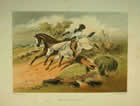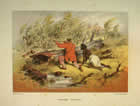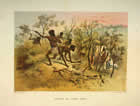In histories of the goldrushes, Aboriginal participation is often ignored or obscured, or Indigenous people are only mentioned in terms of the (very real) negative impact gold had upon culture and lands. But it is clear that Aboriginal people played an important role in daily life on the Victorian goldfields. In the words of Clark and Cahir: ‘Aboriginal people were present on the Ballarat goldfields, and elsewhere, in many capacities, as Native Police, as miners, guides and gold finders, as wives and sexual partners, as farmers and entrepreneurs trading cultural items and food, and as local residents going about their everyday lives, staging corroborees and other forms of interaction with other inhabitants’.
The goldrushes certainly opened up numerous new opportunities for Aboriginal people to take part in the colonial economy. Aboriginal labour was in demand on pastoral stations who had lost most of their men to the diggings. The native police were instrumental in the introduction of La Trobe’s system licensing system on the goldfields.
Aboriginal people were heavily involved in trade on the diggings. A possum skin rug was an extremely valuable item of the goldfields of central Victoria, particularly on cold nights. Diggers were also very reliant on Aboriginal people to act as their guides along the road to the goldfields. Robyn Annear writes:
Aboriginal children along the route would sing out to passing horsemen, 'Are you off to the diggings?’ One early traveller wrote, ‘We frequently got a native to go a distance with us as a guide, for which we gave him a stick of tobacco and “plenty tucker”, viz., damper and mutton, or a bellyful to eat’.
Some Aboriginal people also played a part as goldseekers themselves. One story tells of a group of Aboriginal diggers at Forest Creek refusing to take out mining licences on the grounds that the land, and thus the gold, belonged to them, and not the Queen.
One contemporary observer described the way that the discovery of gold in central Victoria had transformed the economic and social status of some Aboriginal people:
Even the aborigines are wealthy in these times. I met a party of them at Bullock Creek well clothed, with a good supply of food, new cooking utensils, and money in their pockets. One remarked, with becoming expression of dignity, ‘me no poor blackfellow now, me plenty rich blackfellow.
Thomas Ham’s painting, ‘Great Meeting of Gold Diggers Dec’r 15th 1851’ shows some Aboriginal diggers in the central foreground who had formed a ‘party’ with white immigrant miners.






